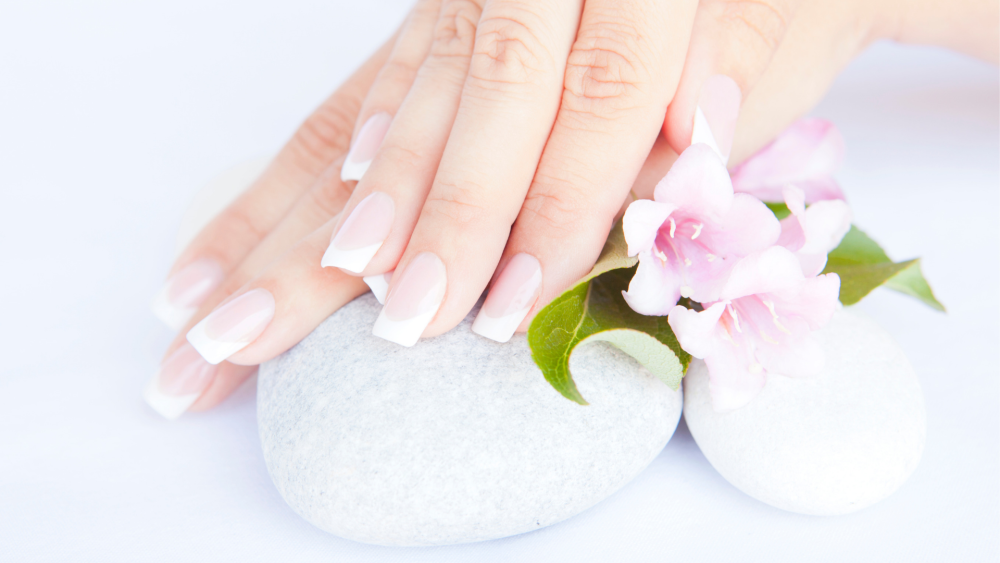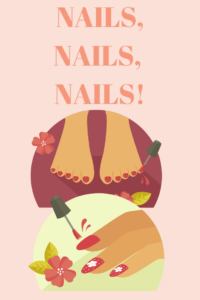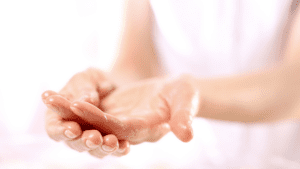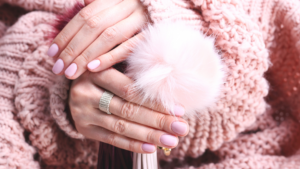
Getting a manicure is a popular choice when it comes to pampering oneself and enhancing overall appearance. It’s not as simple as a brush of base coat, nail polish and a top coat with a quick shape up using a nail file. There are many types of manicures out there which have different benefits that nutrify your hands, feet and of course, nails!
A well-done manicure leaves your nails looking beautiful and makes you feel confident and put together. With a wide range of manicure options available, choosing the right one for your needs can be overwhelming. This comprehensive guide will explore different types of manicures and help you understand which best suits your preferences and style.

Top 12 Different Types Of Manicures
1. French manicure
The founder of the professional nail brand Orly, Jeff Pink is known to have created the look, he wanted to come up with a style that was natural and versatile enough to suit Hollywood actors to wear in between scenes. It was much adored by actors and movie directors. The look was later known as the French manicure in 1976.
A french manicure is a pink base with white nail tips. They are intended to look natural, realistic and be more durable than artificial nails.
The popularity of the french manicure skyrocketed when Pink decided to introduce the style to the runways in Paris during catwalk shows.
French manicures are a popular treatment as it is versatile enough for many people to wear, especially those with strict restrictions to their style when it comes to certain occupations.
The application process for a french manicure is to custom sculpt the nail bed extension and tip onto the nail by applying a bead onto the nail and sculpting it out using the brush and then filed down and finished off with a top coat.
2. Hot oil manicure

A hot oil manicure is a manicure that cleans the cuticles and softens the skin providing a relaxing and nourishing treatment for your hands, feet and nails.
The luxury treatment is the most luxurious option you’ll see on a nail salon’s menu of prices because it works as a saviour for those whose nails are brittle and weak, especially those whose nails are weakened due to constant filing and acrylic nail treatments.
During a hot oil manicure, different oils are used which have specialised properties that create beautiful, nourished hands and nails.
These include:
-
- Almond oil – This contains vitamin E, A, B1, B2 and B6 which coats the nails in a protective layer to prevent the nails peeling, cracking, dryness and breakage. And for the hands, it combats against ageing skin and wrinkles
- Olive oil – Aiding nail growth, it also works as a powerful antioxidising agent in its heated form – this moisturises the cuticles and nutrifies the nails.
- Tea tree oil – Tea tree has natural antibacterial properties which makes it a natural remedy for nail fungus.
- Sunflower oil – This oil also contains vitamin E which is known to heal and replenish skin cells. Vitamin E also has anti-inflammatory features that can help treat atopic dermatitis (eczema).
3. Paraffin wax treatment

A paraffin wax treatment is an add on treatment to a manicure or pedicure, giving a luxurious addition to a standard nail treatment.
The treatment includes a client’s hands, feet and forearm dipped several times into a tub of paraffin wax that is heated to 35 °C. The freshly heated wax is glazed over your hands, feet and forearms.
Paraffin wax is made from petroleum which is commonly used to intensely moisturise skin, it also is infused with botanical ingredients (aloe vera, azulene, chamomile and tea tree oil) and fruit waxes (e.g, apple, peach and strawberry). The intense heat allows for the mineral oil to be absorbed deeper into the skin so it is enriched in moisture.
With many benefits to getting a paraffin wax treatment, it’s no surprise it has risen in popularity over the years. Benefits include opening the pores and removing dead skin cells to rejuvenate your skin leaving it silky smooth and supple.
There are also therapeutic advantages as it is a type of thermotherapy. It increases blood flow which in turn relaxes the muscles. Especially in the hands where it relieves tension in the joints and any pain. A paraffin wax treatment can alleviate symptoms of fibromyalgia and arthritis and alleviate the pain of inflammation, sprains and pulled muscles.
4. Dip powder manicure

These are an alternative to traditional acrylic nails and gel polish because they are similar to being a hybrid of both nail treatments. They are popular because they are easy to apply on to nails. The application process involves layering cyanoacrylate over the natural nail and encasing either the fibre or acrylic powder.
The powder is finely milled which is perfect to achieve a smooth and even application when dipping the nails into the powder. The powder comes in a variety of colours.
The powder is formulated with vitamins and calcium to strengthen the nails instead of harsh chemicals which can weaken the nails causing long term negative effects.
Dip powder manicures are a healthy form of acrylic nails and instead of using UV light to cure the nails, a sealant is applied after layers of the base coat and the dip powder are done.
5. Classic Manicure
A classic manicure is a timeless beauty treatment that focuses on grooming and enhancing the appearance of the nails and hands. It typically involves several steps to achieve a polished and refined look. The first step is to soak the hands in warm water to soften the cuticles and nails. Next, the nails are shaped and trimmed to the desired length and style. The cuticles are then pushed back gently, and any excess skin is carefully removed.
After properly preparing the nails and cuticles, a base coat is applied to protect the nails and create a smooth surface. This is followed by applying two coats of nail polish, allowing each coat to dry before applying the next. Once the polish is dry, a top coat is added to seal and protect the colour, giving the nails a glossy finish. Finally, a moisturizing hand cream is massaged into the hands, leaving them soft and nourished.
A classic manicure is versatile and suits various occasions and personal styles. It offers a clean and well-groomed appearance, enhancing the natural beauty of the hands. Whether you prefer a subtle and neutral colour or a bold and vibrant shade, a classic manicure is an excellent way to keep your nails looking elegant and polished.
6. Gel Manicure
A gel manicure is a type of nail treatment that involves the application of gel polish to natural nails. Unlike traditional nail polish, gel polish is cured under a UV or LED lamp, which hardens and sets the gel. This results in a long-lasting and durable manicure that lasts two to three weeks without chipping or peeling.
The process of getting a gel manicure usually involves several steps:
- The nails are cleaned, shaped, and buffed to create a smooth surface.
- A base coat of gel polish is applied and cured under the lamp. After that, two or three coats of coloured gel polish are used, each fixed layer under the light.
- A top coat is applied and cured to seal the colour and provide a glossy finish.
One of the main advantages of a gel manicure is its longevity. The gel polish is highly resistant to everyday wear and tear, making it ideal for individuals who want a long-lasting manicure. Additionally, gel polish dries instantly under the UV or LED lamp, eliminating the need to wait for the nails to dry. However, it’s important to note that gel manicures require proper removal techniques to prevent damage to the natural nails. Overall, gel manicures are convenient and durable for those seeking flawless, long-lasting nail treatment.
7. Acrylic Manicure
An acrylic manicure is a popular nail enhancement technique that involves applying a combination of liquid monomer and powdered polymer onto the natural nails. The mixture forms a durable, rugged layer that can be shaped, filed, and polished to create the desired nail look. Acrylic manicures offer several advantages, such as long-lasting wear, strength, and versatility in design.
They are known for their ability to withstand daily activities without chipping or breaking easily, making them a preferred choice for individuals seeking durable and low-maintenance nail enhancements. Moreover, acrylic nails can be customized with various colours, patterns, and nail art, allowing individuals to express their creativity and personal style.
While acrylic manicures provide numerous benefits, it’s essential to consider some potential drawbacks. The application process involves the use of strong chemicals and requires professional expertise. Improper application or removal can lead to damage to the natural nails, including thinning or weakening. It is crucial to seek the services of a skilled nail technician who can ensure the proper preparation, application, and removal of acrylic nails to minimize the risk of nail damage.
Additionally, frequent exposure to the chemicals used in the process may cause some individuals to experience allergic reactions or skin sensitivities. Taking proper precautions and consulting with a professional if you have any concerns or sensitivities before getting an acrylic manicure is essential.
8. Shellac Manicure
A shellac manicure is a popular nail treatment that combines gel and traditional nail polish benefits. It involves applying layers of special gel polish onto the nails and curing each layer under a UV or LED lamp. The result is a long-lasting and durable manicure lasting up to two weeks without chipping or peeling. Shellac manicures offer a glossy and smooth finish that enhances the appearance of the nails.
Additionally, the gel formula provides extra strength and protection to the natural nails, making them less prone to breakage. Overall, a shellac manicure is an excellent option for those who want a beautiful, long-lasting manicure requiring minimal maintenance.
- Preparation: Nails are filed, shaped, and gently buffed.
- Base Coat: A layer of shellac polish is applied to the nails.
- Curing: The nails are cured under a UV or LED lamp to harden the base coat.
- Coloured Polish: Two or three layers of coloured shellac polish are applied, each cured before the next.
- Top Coat: A top coat is applied to seal the Manicure
- Manicure and provide a high-gloss finish.
- Curing Process: The nails are cured again to ensure the polish sets and hardens, making it chip-resistant and durable.
- Removal: It is recommended to visit a professional nail salon for removal. The polish is soaked off using acetone to avoid damaging the natural nails.
9. Nail Art Manicure
Nail art manicure is a popular trend in beauty and fashion. It involves the creative and artistic application of designs, patterns, and decorations on the nails. Nail technicians or enthusiasts use techniques and tools like nail polish, nail stickers, gems, and even tiny brushes to create intricate and eye-catching nail designs.
This self-expression allows individuals to showcase their style and creativity through their fingertips. Nail art manicure has gained immense popularity due to its versatility and ability to complement any outfit or occasion, making it a go-to choice for individuals looking to add extra glamour to their overall look.
Nail art manicure offers many possibilities and options to suit different preferences and moods. From simple and minimalistic designs to elaborate and ornate creations, there is something for everyone. Some people opt for classic French manicures with a twist, while others experiment with vibrant colours, geometric patterns, or floral motifs. Nail art manicure has also become a form of self-care and relaxation for many, as the process of creating intricate designs on the nails can be both therapeutic and enjoyable.
With countless designs, colours, and techniques to explore, nail art manicure has become a creative outlet for individuals to express their individuality and stay on-trend in the ever-evolving fashion world.
10. Stiletto Manicure
A stiletto manicure is a trendy nail art style with long, pointed nails resembling stiletto heels. This unique and edgy Manicure has gained popularity recently due to its bold and fashion-forward appearance. The nails are typically shaped into a sharp point and can be customized with various designs, colours, and embellishments. The stiletto manicure requires a skilled nail technician to shape and file the nails into the desired pointed shape while ensuring they remain strong and durable. It’s a statement-making manicure that adds a touch of glamour and sophistication to any look, making it a popular choice among fashion enthusiasts and those looking to make a bold statement with their nails.
With a stiletto manicure, your nails become an instant fashion accessory. The elongated, pointed shape creates a dramatic effect that can’t be achieved with traditional nail shapes. Whether you opt for a classic monochromatic look, vibrant colours, intricate nail art, or even 3D embellishments, the stiletto manicure offers endless possibilities for creativity and self-expression.
However, it’s worth noting that maintaining stiletto nails requires extra care and attention as they can be more prone to breakage. Regular maintenance, such as nail strengthening treatments and gentle handling, is essential to keep your stiletto manicure looking flawless and long-lasting. Overall, the stiletto manicure is a bold and striking nail trend that allows individuals to showcase their unique style and personality through their nails.
11. Airbrush Manicure
An airbrush manicure is a popular nail art technique that involves using an airbrush machine to create intricate designs and patterns on the nails. It offers a unique and professional look that is difficult to achieve with traditional nail polish application methods. The airbrush machine sprays a fine mist of colour onto the nails, allowing for precise and detailed artwork. This highly versatile technique allows for a wide range of designs, from simple gradients and ombre effects to elaborate motifs and intricate patterns. Many nail enthusiasts and professionals favour airbrush manicures for their ability to create stunning and eye-catching nail art.
One of the significant advantages of airbrush manicures is the level of control they offer. The airbrush machine allows for precise colour placement and blending, resulting in a flawless and professional finish. This technique is not limited to a specific nail length or shape, making it suitable for individuals with various nail types and preferences.
Additionally, airbrush manicures often last longer than traditional nail polish applications, as the colour is sprayed onto the nails in thin layers, resulting in a more durable and chip-resistant finish. With the ability to create intricate designs and achieve a long-lasting, professional look, airbrush manicures have become famous for individuals looking to elevate their nail art game.
12. 3D Manicure
A 3D manicure is an innovative and creative way to enhance your nails with three-dimensional designs and embellishments. This unique nail art technique allows for endless possibilities in terms of design and style. With a 3D manicure, you can add texture, depth, and dimension to your nails, making them stand out and catch everyone’s attention. Whether you prefer intricate floral patterns, sparkling rhinestones, or playful cartoon characters, a 3D manicure can transform your nails into miniature works of art. Nail technicians use various techniques such as sculpting, moulding, and hand-painting to create stunning three-dimensional designs that can be customized to suit your personal preferences and occasions.
A 3D manicure offers a fresh and innovative approach to nail art, allowing you to express your creativity and individuality. This type of Manicure has gained popularity due to its ability to make a bold statement and add a touch of glamour to any look. It allows you to experiment with different textures, colours, and shapes, creating a unique and eye-catching nail design. From simple and elegant arrangements to elaborate and intricate creations, a 3D manicure can be tailored to match any occasion, whether a casual outing or a special event. So, if you’re looking to take your nail game to the next level, consider trying out a 3D manicure and let your nails become a stunning piece of art.
Want to do your own manicures? We can help make that a reality!
You can learn how to perform all these types of manicures by studying our Level 2 & 3 Nail Technician course at Ray Cochrane Beauty School.

The course will teach you everything you need to be the best manicurist you can be. You will learn about nail anatomy, manicure and pedicure techniques, UV gel nail extensions, acrylic nail extensions, health and safety, retail skills and reception duties. You will be assessed through a range of methods throughout your time on the course.
The Level 3 Nail Diploma is accredited by VTCT stands for Vocational Teaching Charitable Trust, a government approved awarding body that was previously known as NVQ (which stands for National Vocational Qualification).
The course is widely recognised amongst employers within the industry so you know your new career is in safe hands. Investing in our course gives you a kick start on the right foot by wisely gaining qualifications that demonstrate you are not only talented but competent to follow correct procedures that adds reassurance for your employers and insurance for you.
Frequently Asked Questions
1. Are acrylic nails and gel nails the same thing?
No, acrylic nails and gel nails are not the same. Acrylic nails are made by combining a liquid monomer and a powder polymer, which harden when exposed to air. Gel nails, on the other hand, are created using a gel-like substance that is cured under a UV or LED lamp. Both options provide different benefits and aesthetics.
2. Can I get a manicure if I have weak or damaged nails?
You can still get a manicure if you have weak or damaged nails. In fact, certain types of manicures, such as a nail strengthening treatment or a gel overlay, can help protect and strengthen your natural nails. Be sure to communicate your concerns with the beauty therapist so they can recommend the most suitable option for you.
3. How often should I get a manicure?
The frequency of getting a manicure can vary depending on personal preference and the type of manicure you choose. On average, many people opt for a manicure every two to three weeks to maintain the appearance and health of their nails. However, it ultimately depends on factors such as nail growth and lifestyle factors.
4. Can I get nail art with a gel manicure?
Yes, nail art can be applied on top of a gel manicure. The gel polish serves as a long-lasting base, allowing intricate designs and decorations to be added.
5. Are there manicure options for shorter nails?
Absolutely! Short nails can be beautifully manicured with techniques like shaping, filing, and adding nail extensions or overlays for a polished and chic appearance.
6. Can I remove a gel manicure at home?
While it is possible to remove a gel manicure at home, it is recommended to have it professionally removed to prevent damage to the nails.
To find out more information and enrol in our upcoming course start dates give us a ring on 0203 856 8886 or email us at email@raycohrane.co.uk
